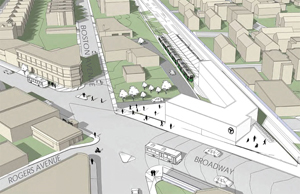
Design details for portions of the GLX extension were unveiled at last week’s meeting at Medford City Hall.
By Francisco L. White
A station design workshop for the Green Line Extension project was held at Medford City Hall on the evening of March 21, in the City Council Chambers.
Designs for the Ball Square and College Avenue stations were presented to members of the affected Somerville and Medford communities. Karen Arpino-Schaffer, the deputy program director for HDR Engineering/Gilbane, began by explaining that the designs are “at thirty percent” and are “works in progress.” HDR/Gilbane is in collaboration with Crosby, Schlessinger, Smallridge LLC, a Boston-based landscape architecture firm, for the station designs. The contemporary structural and landscape plans were displayed prominently throughout the room, as various project contributors led the meeting with a compelling powerpoint presentation. Among them was Michael Epp, an architect from Kleinfelder/SEA Consultants who is active in the design process. Epp said, “This is an amazing project and we are all blessed to be working on it.”
Attendees were provided with two station workshop community involvement action lists, one for each of the station designs presented, containing comments from residents of the communities involved and any actions taken to address their concerns.
The designs, in their current state, appear to have taken community aesthetic, accessibility, and local business into consideration. Many trees sacrificed during construction will be replaced. In fact, College Avenue will feature a shade garden. Also, the stations will be quite accessible for people with disabilities.
Project designers expressed a commitment to “meet or exceed Americans with Disabilities Act standards” in development of the seven stations that will complete the extension.
Bicycle riders will be pleased by ample accommodation as well; 72 enclosed spaces and 20 uncovered spaces for bikes are included in the College Ave. plans. Michael Epp pointed out that there is also a commitment to trying to acquire building materials from local companies “within a 500-mile radius, because that’s just good business.”
With daily ridership expected to reach nearly forty-five thousand by the year 2030, community involvement in the project is not only welcome but essential. Schaffer stressed that the project’s key figures can be expected to “work hand in hand with every neighbor” throughout the design and development process.
















Reader Comments